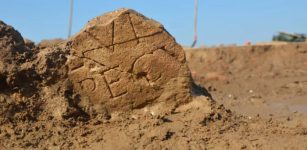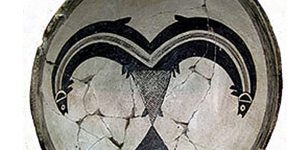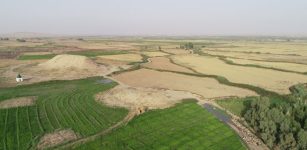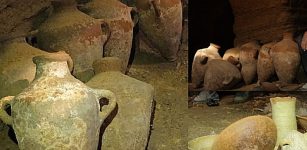Archaeologists Highlight The Tartessos Culture’s Sustainable Construction Skills
Conny Waters - AncientPages.com - An international team of researchers has conducted pioneering studies at the Casas del Turuñuelo site in Guareña, Badajoz, Spain.

Mudbrick wall documented in the south corridor of the structure and a selection of imported materials, including glass bowls from the Eastern Mediterranean and a fragment of Pentelic marble sculpture. Credit: Project Construyendo Tarteso
The archaeological site is recognized as the most well-preserved earthen building in the western Mediterranean.
Due to its exceptional state of preservation, researchers from the Universities of Helsinki and Murcia, in collaboration with the Institute of Archaeology (CSIC—Junta de Extremadura), have been able to successfully reconstruct the construction process of this monumental edifice.
Esther Rodrigues Gonzales and Sebastian Celestino Perez from CSIC have led the excavation efforts at this site since 2014.

Mudbrick wall documented in the south corridor of the structure and a selection of imported materials, including glass bowls from the Eastern Mediterranean and a fragment of Pentelic marble sculpture. Credit: Project Construyendo Tarteso
"Our goal was to understand how the earthen materials were processed and used, the organization of labor, and the skill levels of the community involved in the construction,” Marta Lorenzon from the University of Helsinki, a key research team member, said.
“We aimed to shed light on the construction methods, environmental exploitation, and the socio-political structures that enabled the creation of such monumental architecture."
Benjamín Cutillas Victoria, one of the co-authors of the research, explains that the Tartessians' use of earthen construction was a highly adapted and sustainable method.
The fact that they thrived using this form of architecture adds a new dimension to the story of their building skills and culture, one that has yet to be emphasized much in previous research.
This achievement serves as a testament to the advanced architectural skills of the Tartessians, while also emphasizing their sustainable approach to construction that harmonizes with the local environment.
Casas del Turuñuelo archaeological site. (A) Location of the site in the context of the Iberian peninsula(Digital Terrain Model from OpenStreetMaps, QGIS version 3.4.6); (B) Map of the settlement of the Middle Guadiana Valley during the sixth/fifth centuries BC (DTM from Instituto Geográfico Nacional de España, QGIS version 3.4.6); (C) Aerial view of the Casas del Turuñuelo tumulus, 2017. Credit: Credit: Proyecto Construyendo Tarteso
"This research can help us better understand sustainable building practices from the past that might inspire modern construction. The use of local, natural resources in a coordinated manner could offer ideas for eco-friendly building approaches today," said Lorenzon.
Furthermore, understanding how ancient societies organized labor and managed resources can offer valuable insights for modern-day project management and workforce coordination.
"The ability to reconstruct these ancient techniques provides invaluable insights into how this protohistoric culture thrived and adapted, offering a new dimension to our understanding of their ingenuity and resilience," Lorenzon concludes.
Paper
Benjamín Cutillas-Victoria et al, "Hierarchical organization and skilled workforces for constructing the Tartessic earthen building at Casas del Turuñuelo (Guareña, Spain"), Scientific Reports (2024). DOI: 10.1038/s41598-024-70374-x
Written by Conny Waters - AncientPages.com Staff Writer





















